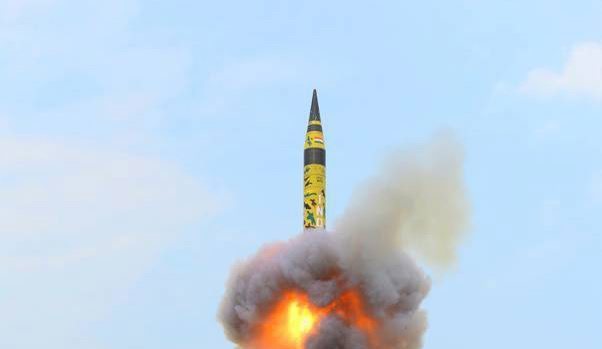
The long range nuclear capable ballistic missile Agni-5 lifts off as it was successfully test fired from mobile launch pad-4 of the Integrated Test Range (ITR) at APJ Abdul Kalam Island in the Bay of Bengal on Sunday, June 03, 2018. A PTI Photo.
BALASORE, ODISHA (PTI): India on Sunday successfully test-fired indigenously developed nuclear-capable ballistic missile Agni-5, with a strike range of 5,000 km, from a test range off the Odisha coast.
The surface-to-surface missile was fired from a mobile launcher at the Integrated Test Range on Dr APJ Abdul Kalam Island, previously known as Wheeler Island, at 9.45 am, defence sources said.
Describing the flight test from launchpad-4 as successful, a defence press note said, "All the radars, electro-optical tracking stations and telemetry stations tracked the vehicle all through the course of the trajectory. All the mission objectives have been achieved."
Defence Minister Nirmala Sitharaman congratulated Defence Research and Development Organisation (DRDO) scientists, staff, the armed forces and industries for the success of "A5 Mission," it added.
This was the sixth trial of the state-of-the-art Agni-5, which covered its full distance during the test.
Unlike other missiles of the series, Agni-5 is the most-advanced in terms of navigation and guidance, warhead and engine, a DRDO official said.
Several new technologies were successfully tested during the Agni-5 trial.
Navigation systems, very-high accuracy Ring Laser Gyro-based Inertial Navigation System and the most-modern and accurate Micro Navigation System ensured the missile reached within a few metres of the target, the official explained.
"The high-speed on-board computer and fault tolerant software, along with robust and reliable bus, guided the missile flawlessly," he said.
Agni-5, a re-entry vehicle, after reaching the peak of its trajectory turns towards Earth and moves towards the intended target with an increased speed due to the planet's gravitational pull. The missile's path is directed precisely by the advanced on-board computer and inertial navigation system.
As the missile enters Earth's atmosphere, the atmospheric air rubbing its skin during the re-entry phase raises the temperature beyond 4,000 degrees Celsius, sources said.
However, the indigenously designed and developed carbon-carbon composite heat shield provides thermal protection to the payload by maintaining the temperature inside the vehicle below 50 degrees Celsius, they said.
The missile has been designed to hit the designated target point accurately, guided by the on-board computer with the support of a Ring Laser Gyro-based Inertial Navigation System, the Micro Inertial Navigation System, fully-digital control system and advanced compact avionics, they said.
Ships located in mid-range and near the target point, tracked the vehicle and witnessed the final event. Radars and electro-optical systems on the path monitored all parameters of the missile and displayed in real time, they added.
The first two flights of Agni-5 in 2012 and 2013 were in open configuration.
The third, fourth and fifth launches were from canister integrated with a mobile launcher, in its deliverable configuration to enable launch of the missile with a very short preparation time as compared to an open launch.
It also has advantages of higher reliability, longer shelf life, less maintenance and enhanced mobility, the sources said.
India has in its armoury the Agni series - Agni-1 with 700 km range, Agni-2 with a 2,000-km range, Agni-3 and Agni-4 with 2,500 km to more than 3,500-km range.
The first test of Agni-5 was conducted on April 19, 2012, the second on September 15, 2013, the third on January 31, 2015 and the fourth on December 26, 2016.
The fifth test was held on January 18 this year. All the five trials were successful.
 Previous Article
Previous Article Next Article
Next Article













The Indian Air Force, in its flight trials evaluation report submitted before the Defence Ministry l..
view articleAn insight into the Medium Multi-Role Combat Aircraft competition...
view articleSky enthusiasts can now spot the International Space Station (ISS) commanded by Indian-American astr..
view article